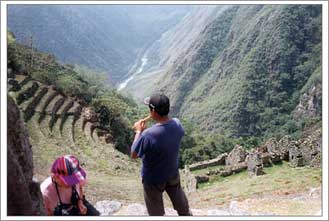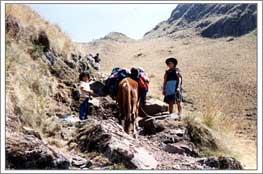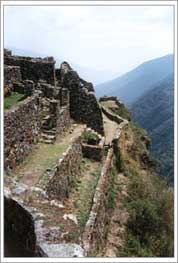Helen Rose's Hill Walking Diary, Machu Picchu - June, 2001
Inca Trail to Machu Picchu

Due to the Foot and Mouth Disease outbreak in Britain, walking in mountains has been severely curtailed so I am writing about walking the Inca Trail to Macchu Pichu in Peru. I travelled to Peru with an adventure company as I was limited for time and the trip incorporated all the things I wanted to do in two weeks. The trip included visits to Lima, Puno on Lake Titicaca, a train journey across the Altiplano and lastly to Cuzco which were all of great interest but the highlight was walking the Inca trail to Macchu Pichu.
The Group were fully supported by an entourage of porters and cooks and it was truly camping for softies. Camping is the only alternative as the route is footpath only and there is no other accomodation on it. Mules were used by the porters for carrying luggage on part of the walk but otherwise the porters carried everything tied in a blanket. The Group were well clothed including walking boots and only a day pack but the porters carried heavy loads wearing flimsy sandals and still were much faster than we were in walking at altitude.
The route crosses the scenic Andean landscape of snowy peaks and lush tropical rainforests running across the 'Machu Picchu Historical Sanctuary' with part of it over the the ancient Inca Highway which connected Cuzco with Machu Picchu. The trail has only been open to walkers since 1970 and was first explored by Hiram Bingham in 1911. There are limits imposed on the number of walkers on the trail at any give time for conservation reasons.

The trek started at Chilca where we crossed the Urubamba River and followed its rapids down the Sacred Valley of the Incas to Llactapata where we camped above the ruins. Afternoon tea awaited us at the campsite where the tents had been set up by the porters. On the way we had passed a farm where the workers were drinking a white milky mixture which turned out to be home made beer. There were guinea pigs in cages as the local delicacy is roast guinea pig. At the churches in Lima the Last Supper paintings depict a meal with roast guinea pig as the central dish. This was an easy day of walking to prepare us for the following days where we would feel the effects of altitude. The sky at night was a carpet of stars very different to what we see in the Northern Hemisphere and with no light pollution.
On the second day we passed Huayllabamba, a village of Inca origins which is the last settlement on the route. From the campsite at LLulluchapampa we had stunning views of the snowy peaks around us as we were now at an altitude of 3,800 metres. The following day we ascended to an altitude of 4,200 metres to trek over Warmiwanusca (Dead Woman) Pass where we had a cooked lunch prepared by the cooks. They can do wonders on a camp stove at high altitude. This is well below the snow level and the area around was green. . From the valley of the Pacamayo River with its tropical vegetation, we crossed the Runkurakay Pass and saw the jungle on the slopes of the mountains. We visited the Sayacmarka Ruins walled in on a rocky promitory by crossing a narrow granite stairway. The elliptical fortified tower is still standing and is well worth the visit for the stunning views of the jungle and mountains around. For me, this was the best day walking in the jungle with the guide pointing out the flora including orchids and large epithytes. We passed through an Inca Tunnel to the Phuyapatamarca Ruins where we could see the white rapids of the Urubamba River below us. The Peruvian Guide welcomed us into the ruins by playing a haunting tune on the pan pipes. The ruins were very atmospheric and can only be reached by trekking. That night, we were happy but tired as trekking at high altitude can be exhausting although the Guides ensured we walked at an easy pace to conserve energy and enjoy the experience of the trail.

On the last day of the trek, we descended to Winay Wayna ruins, a small Inca city which like Machu Picchu was abandoned for unknown reasons. We entered Machu Picchu from the 'Gate of the Sun' but the first view was disappointing as the hill is scarred by a winding road. Machu Picchu was very interesting with the ruined temples, palaces and stone dwellings scattered over the siteand the climb up the steep peak of Wayna Picchu is worth it for the views over the ancient city. The following day we took the train back to Cuzco but the trek is the way to visit Machu Pichu to soak up the atmosphere of the Inca Trail and see ruins only accessible on foot.
E mail me on [email protected] with all your comments and any mountains you would like to hear about in Scotland.
Coming attractions; weekend in Ullapool, return to Ratagan and walking in Andalusia.
Thanks to Frances Rickus for the photographs.







